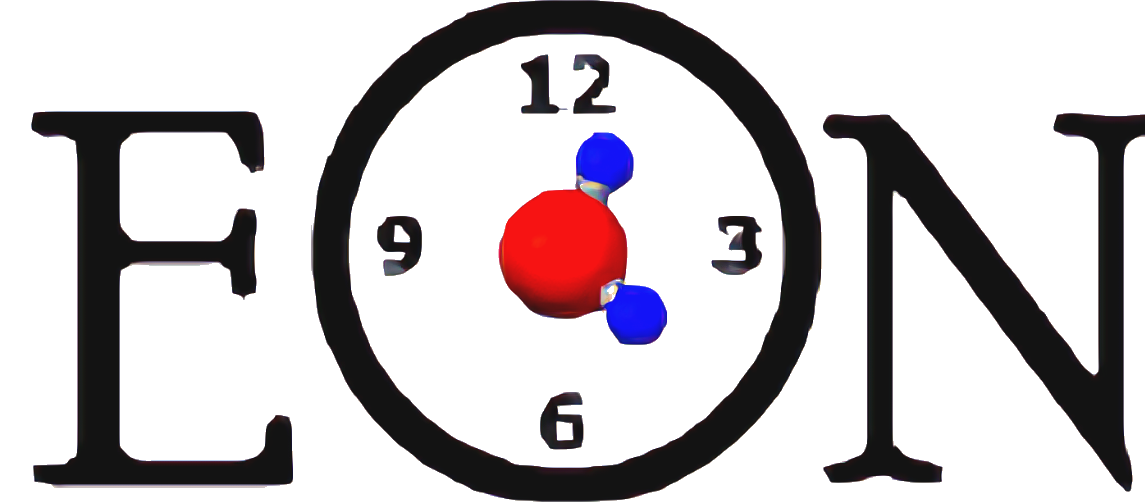Dimer method#
The dimer method of Henkelman and Jónsson [DM_HJonsson99] with improvements by Heyden et al. [DM_HBK05] and Kästner and Sherwood [DM_KastnerS08] for estimating the lowest Eigenmode using only first derivatives.
An overview may be found in Olsen et al. [DM_OKH+04].
The dimer separation is set in the [Main] section with the
finiteDifference parameter.
The method of Melander et al. [DM_MLJonsson15] is also implemented for use with gas phase systems.
Note
There is no point removing rotations for an extended system. Rotation removal may be more detrimental as noted in .
Added in version 2.5_TBA: The Gaussian Process Regression accelerated dimer in C++ from .
Configuration#
[Dimer]
- pydantic model eon.schema.DimerConfig[source]#
Show JSON schema
{ "title": "DimerConfig", "type": "object", "properties": { "opt_method": { "default": "cg", "description": "Optimization algorithm to choose the dimer rotation direction.", "enum": [ "sd", "cg", "lbfgs" ], "title": "Opt Method", "type": "string" }, "converged_angle": { "default": 5.0, "description": "The dimer is considered converged if it will be rotated fewer degrees than this angle.", "title": "Converged Angle", "type": "number" }, "rotations_max": { "default": 10, "description": "This is the maximum number of rotations allowed for the dimer for each minimum mode estimation.", "title": "Rotations Max", "type": "integer" }, "dimer_rotation_angle": { "default": 0.005, "description": "Finite angle for dimer rotation.", "title": "Dimer Rotation Angle", "type": "number" }, "dimer_improved": { "default": true, "description": "Indicates if the improved dimer method is used.", "title": "Dimer Improved", "type": "boolean" }, "dimer_max_iterations": { "default": 1000, "description": "Maximum number of iterations allowed for the dimer.", "title": "Dimer Max Iterations", "type": "integer" }, "dimer_rotations_min": { "default": 1, "description": "Minimum number of rotations for the dimer. [not improved]", "title": "Dimer Rotations Min", "type": "integer" }, "dimer_torque_min": { "default": 0.1, "description": "Minimum torque for the dimer. [not improved]", "title": "Dimer Torque Min", "type": "number" }, "dimer_torque_max": { "default": 1.0, "description": "Maximum torque for the dimer. [not improved]", "title": "Dimer Torque Max", "type": "number" }, "dimer_remove_rotation": { "default": false, "description": "Indicates if the rotation should be removed.", "title": "Dimer Remove Rotation", "type": "boolean" } } }
- Config:
use_attribute_docstrings: bool = True
- Fields:
- field converged_angle: float = 5.0#
The dimer is considered converged if it will be rotated fewer degrees than this angle.
- field dimer_remove_rotation: bool = False#
Implements the method of Melander et al. [DM_MLJonsson15]
Indicates if the rotation should be removed.
- field opt_method: Literal['sd', 'cg', 'lbfgs'] = 'cg'#
- Options:
‘sd’: Steepest descent, rotate along the rotational force.
‘cg’: Conjugate gradient, rotate along conjugate directions.
‘lbfgs’: Limited memory Broyden-Fletcher-Goldfarb-Shanno Quasi-Newton optimizer.
Optimization algorithm to choose the dimer rotation direction.
References#
Graeme Henkelman and Hannes Jónsson. A dimer method for finding saddle points on high dimensional potential surfaces using only first derivatives. The Journal of Chemical Physics, 111(15):7010–7022, October 1999. doi:10.1063/1.480097.
Andreas Heyden, Alexis T. Bell, and Frerich J. Keil. Efficient methods for finding transition states in chemical reactions: Comparison of improved dimer method and partitioned rational function optimization method. The Journal of Chemical Physics, 123(22):224101, December 2005. doi:10.1063/1.2104507.
Johannes Kästner and Paul Sherwood. Superlinearly converging dimer method for transition state search. The Journal of Chemical Physics, 128(1):014106, January 2008. doi:10.1063/1.2815812.
Marko Melander, Kari Laasonen, and Hannes Jónsson. Removing External Degrees of Freedom from Transition-State Search Methods using Quaternions. Journal of Chemical Theory and Computation, 11(3):1055–1062, March 2015. doi:10.1021/ct501155k.
R. A. Olsen, G. J. Kroes, G. Henkelman, A. Arnaldsson, and H. Jónsson. Comparison of methods for finding saddle points without knowledge of the final states. The Journal of Chemical Physics, 121(20):9776–9792, November 2004. doi:10.1063/1.1809574.
